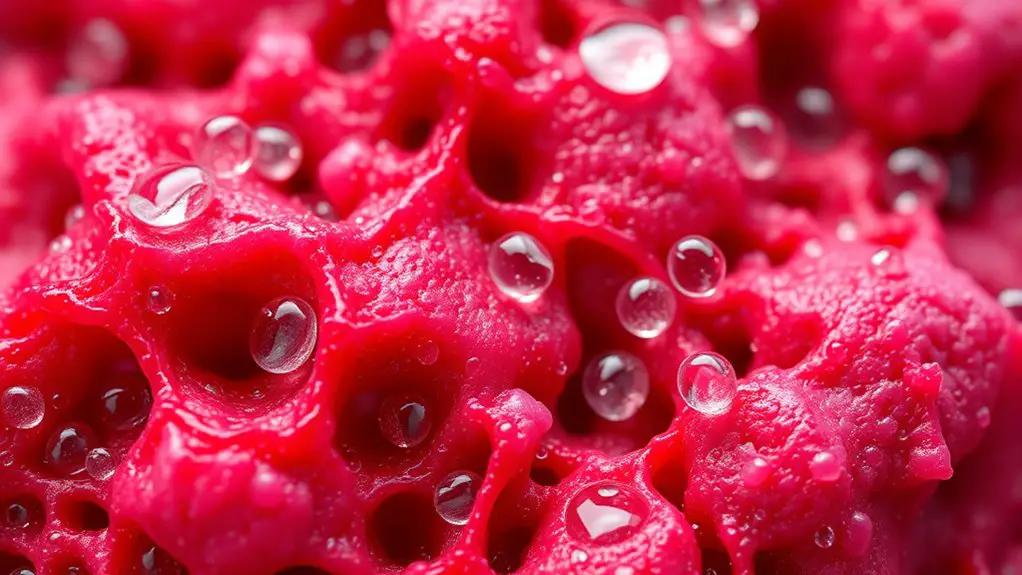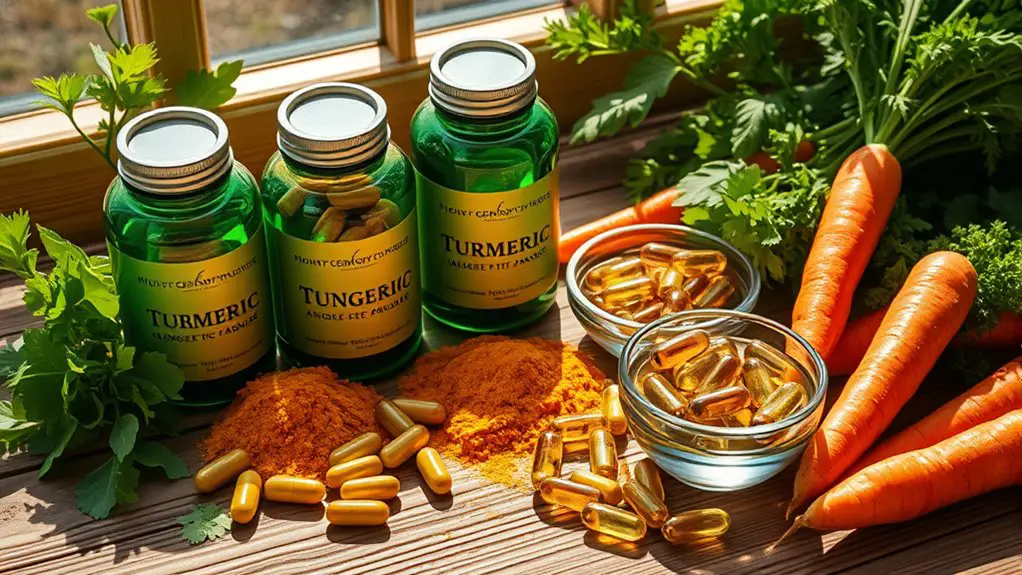Inflammation plays an essential role in your body's healing process. It can be acute—helping with immediate recovery—or chronic, which may hinder healing and lead to health problems. Factors like age, sleep quality, and nutrition greatly influence your recovery time. Maintaining a balanced approach to exercise and managing stress can further enhance your healing. Understanding these elements can help you optimize your recovery journey. You'll find more insights on how to manage inflammation effectively.
Understanding Inflammation: A Double-Edged Sword
Although inflammation is often viewed negatively, it plays an essential role in your body's healing process. When you experience an injury or infection, your immune system kicks into gear, sending out signals to increase blood flow and recruit white blood cells. This response helps protect and repair your tissues, allowing you to recover more swiftly.
However, too much inflammation can become a double-edged sword. While it's important for healing, chronic inflammation can lead to various health issues, such as autoimmune disorders and chronic pain. It's essential to strike a balance; your body needs to know when to respond and when to dial it back. Additionally, engaging in proper warm-ups can help reduce the risk of injuries that trigger inflammatory responses. Embracing this natural process can empower you to understand your body better. By listening to its signals, you can nurture your well-being and support your recovery journey, allowing you to reclaim the freedom to move and live fully.
The Role of Cytokines in the Healing Process
Cytokines play an essential role in the healing process, acting as the communication network of the immune system. They're like messengers, sending signals that tell your body when to ramp up defenses and when to dial it down. When you're injured or facing an infection, cytokines release to recruit immune cells, ensuring your body's response is swift and effective.
You might not realize it, but this intricate balance is critical for recovery. Too few cytokines can slow healing, while too many can lead to excessive inflammation. By regulating inflammation, they help create an environment that fosters tissue repair and regeneration.
Understanding this delicate interplay gives you insight into how your body fights for freedom from pain and dysfunction. When you nourish your body with proper nutrition and rest, you support this remarkable system, allowing cytokines to do their job and promote healing, so you can regain your vitality.
Acute vs. Chronic Inflammation: Key Differences
When you think about inflammation, it's important to recognize the differences between acute and chronic forms. Acute inflammation lasts a short time and often results from specific triggers, while chronic inflammation can linger for months or even years, often without a clear cause. Understanding the symptoms and effects of each type can help you manage your recovery more effectively.
Duration of Inflammation
Inflammation can manifest in two distinct forms: acute and chronic, each with its own duration and implications for recovery. Acute inflammation is your body's immediate response to injury or infection, usually lasting a few days to weeks. You might experience redness, heat, and swelling, but this phase often leads to healing and resolution. On the other hand, chronic inflammation persists for months or even years, often due to ongoing stressors or health issues. This long-term state can hinder recovery and lead to various health complications. Understanding the differences in duration helps you take charge of your health, guiding you toward choices that promote healing and ultimately enhance your sense of freedom and well-being.
Causes and Triggers
Although inflammation is a natural response, its causes and triggers can vary greatly between acute and chronic types. Acute inflammation kicks in quickly, often due to injuries, infections, or allergens. Think of it as your body's immediate reaction, like a fire alarm going off when there's smoke. On the other hand, chronic inflammation lingers long-term, often sparked by ongoing stressors like poor diet, lack of exercise, or autoimmune disorders. It's like a slow-burning fire that never fully goes out. Recognizing these differences is essential because they influence how you approach recovery. By understanding what triggers your body's inflammatory response, you can take steps toward achieving better health and reclaiming your freedom to feel good.
Symptoms and Effects
Understanding the causes and triggers of inflammation sets the stage for recognizing its symptoms and effects. Acute inflammation often shows up as redness, swelling, heat, and pain, signaling your body's immediate response to injury or infection. You'll feel discomfort, but this response is generally short-lived, allowing for rapid healing. On the flip side, chronic inflammation can be insidious, lingering over time and causing fatigue, joint pain, and even contributing to serious health issues like heart disease or diabetes. It's essential to listen to your body; if you notice persistent symptoms, it might be time to seek help. By understanding these key differences, you can empower yourself to take charge of your health and recovery journey.
Factors Influencing Recovery Time
When it comes to recovery time, several factors play an important role in determining how quickly you bounce back from an injury or illness. Your age can greatly influence healing; younger bodies often recover faster. Activity level matters too—if you're generally active, you might experience quicker recovery than someone sedentary. Stress levels also come into play; chronic stress can slow down your healing process.
Genetics can't be overlooked either; some people naturally heal more efficiently than others. Sleep quality is another vital factor. Prioritizing restorative sleep allows your body to repair itself effectively, as proper sleep is crucial for muscle health and recovery.
Lastly, your mental attitude affects recovery; staying positive can enhance resilience. Embracing freedom in your recovery journey means understanding these factors and taking charge of the aspects you can influence. By being proactive and mindful, you can optimize your recovery time and return to doing what you love sooner.
The Impact of Nutrition on Inflammation and Healing
Nutrition plays an essential role in managing inflammation and promoting healing, especially when you're recovering from an injury or illness. What you eat can either fuel inflammation or help reduce it. Foods rich in omega-3 fatty acids, like salmon and walnuts, can be your allies, as they possess anti-inflammatory properties. On the flip side, processed foods and excessive sugar can ramp up inflammation, hindering your recovery.
Incorporating plenty of fruits and vegetables into your diet provides important vitamins and antioxidants that support your body's healing processes. Staying hydrated is equally important; water helps transport nutrients and flush out toxins.
Don't overlook the power of whole grains and lean proteins—they're key players in tissue repair. By consciously choosing nourishing foods, you can empower your body to heal more effectively and regain your freedom to move and live life fully. Your nutrition choices can truly make a difference in your recovery journey. Additionally, adequate protein intake is crucial as it supports rebuilding and fortifying muscles during recovery.
Exercise and Inflammation: Finding the Right Balance
When it comes to exercise and inflammation, understanding the types of inflammation you might encounter is essential. The intensity of your workouts can markedly impact how your body responds and recovers. By exploring effective recovery strategies, you can find the right balance that works for you. Quality sleep is crucial for muscle recovery and can significantly reduce inflammation, aiding in your overall recovery time.
Types of Inflammation
Inflammation plays an essential role in how your body responds to exercise, striking a delicate balance between promoting recovery and causing harm. There are two main types of inflammation: acute and chronic. Acute inflammation is your body's immediate response to injury or stress, helping to repair tissues and promote healing. You might experience this after an intense workout, feeling soreness as your muscles recover. On the other hand, chronic inflammation creeps in when your body remains in a constant state of stress, leading to fatigue and even injury over time. Understanding these types can help you navigate your fitness journey, ensuring you push your limits without compromising your health. Find that sweet spot where inflammation aids your progress instead of hindering it.
Exercise Intensity Impact
Finding the right balance between exercise intensity and inflammation is essential for optimizing your recovery. When you push too hard, your body can react with increased inflammation, slowing down your healing process. It's important to listen to your body; moderate exercise can promote recovery, while excessive intensity may lead to setbacks. Finding that sweet spot allows you to enjoy the freedom of movement without compromising your well-being. Consider incorporating various intensities into your routine—mixing high-intensity workouts with lighter sessions gives your body time to adapt and recover. Ultimately, it's about tuning into how you feel and adjusting accordingly, ensuring that your passion for fitness doesn't hinder your journey toward health and wellness.
Recovery Strategies Effectiveness
Balancing exercise intensity can greatly influence how effectively you recover from workouts. If you push too hard without adequate recovery, you might find yourself battling inflammation, which can hinder your progress. Incorporating active recovery days, like light jogging or yoga, can help maintain your momentum without overdoing it. Don't forget about nutrition; fueling your body with anti-inflammatory foods, like leafy greens and omega-3s, plays an essential role in recovery. Hydration is equally important; staying well-hydrated can help reduce muscle soreness and promote healing. Listening to your body is key—if you're feeling worn out, consider dialing back the intensity. By finding the right balance, you'll enhance your recovery and enjoy more freedom in your training journey.
Common Myths About Inflammation and Recovery
While many people recognize inflammation as a natural response to injury or illness, several myths surround its role in recovery. One common belief is that all inflammation is bad. In reality, acute inflammation is essential for healing; it helps your body fight infections and repair tissue. Another myth is that you must completely suppress inflammation for ideal recovery. In truth, a balance is key—some inflammation is necessary for healing. You might also think that avoiding physical activity entirely will speed up recovery. However, gentle movement can actually promote circulation and aid healing. Finally, some people believe that natural remedies alone can replace medical care. While they can support your recovery, they shouldn't be your only approach. Understanding these myths empowers you to embrace a more informed and balanced view of inflammation, allowing you to navigate your recovery journey more freely. Incorporating active recovery techniques, such as light movement, can further enhance your overall healing process.
Strategies to Manage Inflammation for Optimal Recovery
To achieve ideal recovery, it is vital to adopt effective strategies for managing inflammation. Start by incorporating anti-inflammatory foods into your diet, like leafy greens, berries, and fatty fish. These can help reduce inflammation naturally. Don't forget to stay hydrated—water plays a key role in flushing out toxins and aiding recovery. Staying hydrated is essential for optimal performance and also supports the freedom to perform at one's best.
Regular exercise is another powerful tool. Engaging in moderate activity boosts circulation and helps alleviate inflammation. However, listen to your body; rest is equally important. Prioritize sleep, as it is fundamental for recovery and reducing inflammation levels.
Consider mindfulness practices like yoga or meditation. These techniques can mitigate stress, which often exacerbates inflammation. If you're considering supplements, consult a healthcare professional for options like omega-3 fatty acids or turmeric.
Frequently Asked Questions
Can Stress Increase Inflammation and Affect Recovery Time?
Yes, stress can definitely increase inflammation and slow your recovery time. When you're stressed, your body releases hormones that can trigger inflammatory responses, making it harder for you to heal and feel your best.
How Does Sleep Quality Influence Inflammation Levels?
Did you know poor sleep can increase inflammation by 30%? When you prioritize quality sleep, you're not just resting; you're freeing your body to heal, reducing inflammation, and enhancing your overall recovery and well-being.
Are There Specific Supplements That Reduce Inflammation Effectively?
Yes, some supplements, like omega-3 fatty acids, turmeric, and ginger, can effectively reduce inflammation. If you're looking for natural ways to support your body, these options might be worth considering for your wellness journey.
Can Dehydration Contribute to Prolonged Inflammation?
Yes, dehydration can definitely contribute to prolonged inflammation. When you're not well-hydrated, your body's ability to repair and regulate itself diminishes, making it harder for you to recover from inflammation. Staying hydrated's essential!
Does Age Impact Inflammation and Recovery Speed?
Did you know that recovery time can increase by 10% for every decade you age? As you get older, your body's inflammation response slows down, making it essential to prioritize health for quicker healing.




